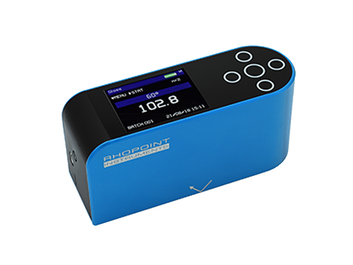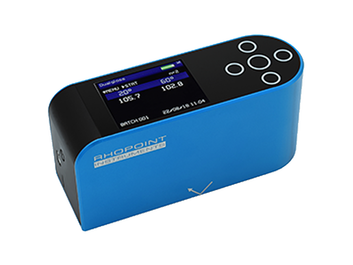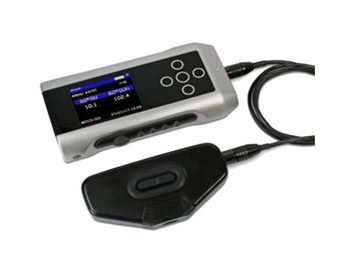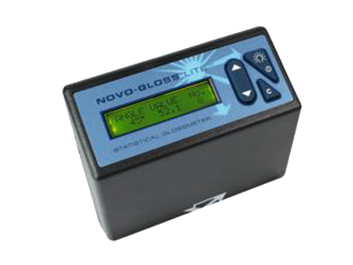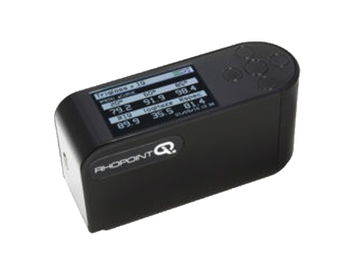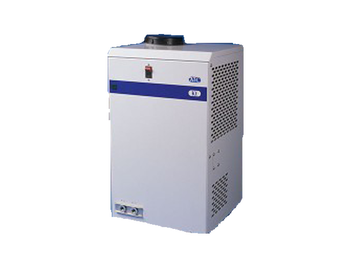Measures the minimum film forming temperature of water based coatings. Determines the MFFT of latex, emulsions and adhesives -10°C to 90°C operation
If you need discussion about this product, please click “Find Solution”. Or click the “Order Now” to buy now.
Paints and Coatings
The minimum film forming temperature (MFFT) of a paint or coating is the lowest temperature at which it will uniformly coalesce when laid on a substrate as a thin film. The standard test for determining this temperature involves using a MFFT-BAR, as specified by such standards as ASTM D 2354 and ISO 2115. The design of the Rhopoint instrument is based directly on these standards.
Adhesives
The MFFT of one-pack adhesives can be found in a similar way to paints and coatings. With two-pack adhesives, a strip of aluminium foil can be laid on the platen, to ease cleaning, before applying the adhesive. Two-pack adhesives do not show an MFFT, but the minimum cure temperature can be found by scraping the sample with a spatula
Design
The new Minimum Film Forming Temperature instrument benefits from an easy to use touch screen interface, digital MFFT temperature calculation and output to handy results labels. These additions to the trusted Rhopoint MFFT make the instrument easier to operate with improved certainty of results.
The temperature bar consists of a copper platen with an electronically imposed temperature gradient. Built in temperature sensors monitor the temperature across the platen, a graph of the gradient is displayed on the touch screen.
Purge gas is integrally dried, and flows over the platen via a sintered distribution block. The hinged perspex cover provides thermal and atmospheric insulation whilst allowing constant visual inspection of a test. A cursor is moved to indicate the identified MFFT point; the instrument calculates and displays the temperature in the required units.
The instrument can be supplied with an optional results label printer. Recorded values include the time and date of the test and identified minimum film forming temperature. The printed label can be attached to retained sample bottles or job sheets.
Features
- Determines the MFFT of latex, emulsions and adhesives
- Easy to use touch screen programme control
- Nickel plated copper platen with an electronically imposed temperature gradient
- Optional results printer for printing date and time stamped MFFT results
- -10˚C to 90˚C operation
Standard model (MFFT-60) has seven temperature programs:
Nickel plated copper platen.
75µm 0.003” cube applicator.
Additional three temperature programs on extended range model (MFFT-90):
Packed Weight53.7kg
| Conforms to | ASTM D 2354, ISO 2115, |
| DIN 53787 | |
| Platen dimensions | 483mm x 235mm ( L x W) |
| Air | 4 l min-1 @ 100 psig |
| Water | Mains pressure; gravity drain |
| inlet temperature <15°C Mains | |
| 110-120V AC or | |
| 220-240V AC | |
| Packed Dimensions | 590mm x 900mm x 690mm (H x W xD) |
| Dimensions | 350mm x 550mm x 610mm ( H x W x D) |
| Weight | 38kg |
The Novo-Gloss 20/60/85° gloss meter is designed to meet the measurement criteria for most gloss measuring applications.
The Novo-Gloss Trio low cost glossmeter is ideal for gloss measurements of all surfaces and is suitable for matt to mirror gloss surfaces
The Novo-Gloss 60 degree gloss meter is suitable for measuring gloss in most applications from matt to high gloss finishes.
The Novo-Gloss Dualgloss gloss-meter is perfect for basic gloss measurement and is best suited for mid to mirror gloss surfaces (10+ GU @60°)
Designed specifically to measure the gloss of surfaces that cannot be measured using traditional gloss-meters, the Novo-Gloss Flex 60 gloss-meter combines the functionality and reporting of an advanced gloss-meter with an ultra lightweight remote measuring head.
The Novo-Curve glossmeter is a unique instrument with specially designed optics for accurately measuring curved surfaces and small areas. It can also be used to measure flat surfaces and areas which are too small to measure with standard glossmeters.
The Novo-Gloss 20/60/75ºS gloss meter is a fully featured instrument measuring the gloss of surfaces.
The Rhopoint Novo-Gloss Lite 45º measures gloss using a specialist geometry often specified in the ceramics, metal manufacturing and film making industries.
The Rhopoint IQ quantifies surface quality problems that are invisible to a standard glossmeter and profiles how light is reflected from a surface.
The Rhopoint IQ Gloss Haze & DOI Meter quantifies surface quality problems that are invisible to a standard glossmeter and profiles how light is reflected from a surface.
The Rhopoint IQ Flex 20 quantifies surface quality problems such as orange and peel and haze that are invisible to a standard glossmeter and profiles how light is reflected from a surface.
The Rhopoint IQ-S was specially designed and built to match automotive interior gloss measurement standards. IQ-S gloss measurements are fully compatible with existing Micro-TRI-gloss-S results.
The Rhopoint IQ Concrete Clarity Meter measures reflected image quality; it is the only hand held instrument that profiles how light is reflected from a surface. Glossmeters are usually used to measure the “shininess” of a surface but are not sensitive to common effects which reduce appearance quality.
Measures the minimum film forming temperature of water based coatings. Determines the MFFT of latex, emulsions and adhesives -10°C to 60°C operation
Measures the minimum film forming temperature of water based coatings. Determines the MFFT of latex, emulsions and adhesives -10°C to 90°C operation
Required when the temperature of the water supply to the instrument is >20ºC higher than the target temperature at the cold end of the
selected range.
The PAINTLAB+ Krebs Viscometer from Rhopoint Instruments offers high accuracy viscosity measurement with advanced functionality.
This Viscometer is specifically designed to provide stringent testing conditions to allow the measurement of these materials as the viscosity changes according to the shear stress that is applied.
The Paintlab+ Viscomixer is a versatile instrument used to measure the change in viscosity during the addition of a solvent or thinner.





